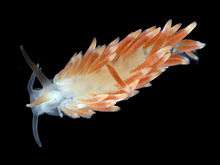Catriona aurantia
| Catriona aurantia | |
|---|---|
 | |
| The nudibranch Catriona aurantia, Gulen Dive Resort, Norway. | |
| Scientific classification | |
| Kingdom: | Animalia |
| Phylum: | Mollusca |
| Class: | Gastropoda |
| (unranked): | clade Heterobranchia clade Euthyneura clade Nudipleura clade Nudibranchia clade Dexiarchia clade Cladobranchia clade Aeolidida |
| Superfamily: | Fionoidea |
| Family: | Trinchesiidae |
| Genus: | Catriona |
| Species: | C. aurantia |
| Binomial name | |
| Catriona aurantia | |
| Synonyms | |
| |
Catriona aurantia is a species of sea slug, an aeolid nudibranch, a marine gastropod mollusk in the family Trinchesiidae.[1] It was incorrectly synonymised with Catriona gymnota from the Western Atlantic but shown to be a distinct species by DNA analysis.[2]
Distribution
This species was described from Whitley, on the North Sea coast of England.[3]
Description
This species has a translucent white body and slightly swollen cerata. The digestive gland is orange pink in colour and the tips of the cerata have a broad white band of tiny epidermal glands. In larger specimens the rhinophores develop a pale orange suffusion. The foot is broad and rounded anteriorly. Large individuals may exceed 20 mm in length.[4]
Habitat
Feeds on the hydroid Tubularia larynx. Individuals are thought to feed by eating through the stems of the hydroid rather than on the polyps. Usually found in exposed places, in strong tidal streams, and in shallow water, from 0 m to 20 m depth. The spawn consists of lozenge-shaped packets of eggs.[4]
References
- ↑ Picton, B.; Rosenberg, G. (2017). Catriona aurantia (Alder & Hancock, 1842). In: MolluscaBase (2017). Accessed through: World Register of Marine Species on 2017-11-02.
- ↑ Korshunova, T.; Martynov, A.; Picton, B. (2017). Ontogeny as an important part of integrative taxonomy in tergipedid aeolidaceans (Gastropoda: Nudibranchia) with a description of a new genus and species from the Barents Sea. Zootaxa. 4324(1): 1.
- ↑ Alder J. & Hancock A. (1842). Descriptions of several new species of nudibranchous mollusca found on the coast of Northumberland. Annals and Magazine of Natural History 9: 31-36.
- 1 2 Picton, B.E. & Morrow, C.C. (2016). Catriona aurantia (Alder & Hancock, 1842). [In] Encyclopedia of Marine Life of Britain and Ireland. Accessed on 2016-12-25.
| Wikimedia Commons has media related to Tenellia gymnota. |